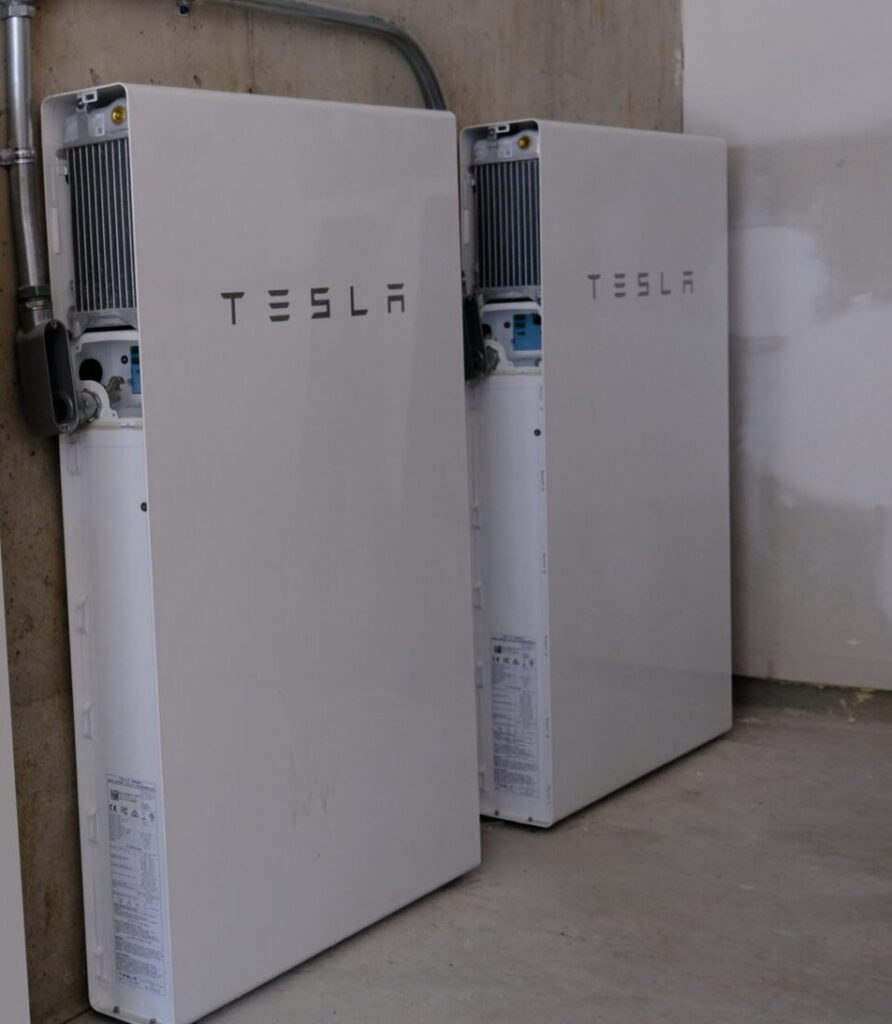
Tesla Powerwall: Leading the Charge
Solar energy helps you control your energy costs, but it can’t prevent blackouts. By pairing your solar system with the Tesla Powerwall, you can enjoy reliable power even when the sun isn’t shining or during a grid outage. Plus, with utilities charging time-based rates, a solar-powered Tesla Powerwall can maximize your savings by storing energy for when it’s most needed.
Learn how Tesla solar batteries seamlessly store excess energy generated by your solar panels during the day, providing reliable power for your home at night or during outages. Gain 24/7 control over your energy and maximize efficiency with this cutting-edge solution.
-
1
Consult
Our team of experts will guide you through the best solar battery options for your home. Choose from our range of high-quality solar batteries.
-
2
Quote
Infinity Energy provides a transparent, all-inclusive quote, covering equipment, installation, and any available rebates or incentives. We ensure you get the best value.
-
3
Installation
Once you’ve selected the battery, we’ll arrange for a quick and professional installation. Our team will seamlessly integrate your solar battery with your existing solar system, ensuring it’s ready to perform at its best.
Solar Battery Storage
At Infinity Energy, we’re not just about installing solar panels—we’re about providing a complete energy solution for your home. When you choose us, you’re choosing:
Frequently asked questions
Get answers to common questions about solar batteries, their benefits, and how they can enhance your energy efficiency and independence.
Do I need to already have solar panels to install a solar battery?
While solar batteries are typically used to store energy from solar panels, you don’t need to already have panels installed to get a battery. However, combining both solar panels and a battery maximizes the efficiency and benefits of renewable energy for your home.
Can I use a Tesla battery during power outages?
Yes! A solar battery provides backup power during outages, allowing you to keep essential appliances running. With systems like the Tesla Powerwall, you can have reliable energy even when the grid goes down.
How much energy can a solar battery store?
The amount of energy a solar battery can store depends on its capacity, typically measured in kilowatt-hours (kWh). Larger batteries can store more energy, allowing for longer use during periods without solar production.
Do solar batteries save money on electricity bills?
Yes, by storing excess solar energy and using it during peak rate hours or when your panels aren’t producing, you can significantly reduce your reliance on the grid and lower your electricity bills.
What is the installation process for a solar battery?
The installation typically takes 1-2 days and involves integrating the battery with your existing solar panels.
How Does a Home Battery Integrate with a Solar Inverter to Capture More Solar Energy?
A home battery system efficiently pairs with a solar inverter to enhance the utility of solar energy in your home. Here’s how the integration works:
- Energy Conversion: The solar inverter’s primary role is to convert direct current (DC) generated by your solar panels into alternating current (AC), the form of electricity used in your home. This conversion takes place while your panels are actively generating solar power during daylight hours.
- Energy Storage: As the solar panels produce energy, any excess electricity that you don’t immediately use is stored in the home battery. This prevents wastage and ensures that none of the captured solar energy is lost.
- Nighttime Usage: Once the sun goes down, the home battery releases the stored energy, allowing you to use solar power even when your panels are not generating electricity. This reduces reliance on the grid and maximizes solar usage.
- Smart Management: Modern systems often come with intelligent management software that optimizes the usage of stored energy. It decides the best times to charge and discharge the battery, ensuring efficient energy management and reduced electricity costs.
By integrating a home battery with a solar inverter, you effectively harness more solar energy, providing power round the clock and boosting the overall efficiency and sustainability of your solar setup.
What Safety and Certification Standards Do Home Battery Systems Meet?
Home battery systems are designed to meet rigorous safety and certification standards to ensure reliability and user protection. These systems typically align with North American safety and electromagnetic interference (EMI) standards. Let’s delve into the key certifications they often achieve:
- UL Certification: Many home battery systems are certified by Underwriters Laboratories (UL), which ensures that the products meet stringent safety criteria for electrical components and systems.
- IEEE Standards: Compliance with standards set by the Institute of Electrical and Electronics Engineers (IEEE) ensures that the systems perform efficiently and safely within electrical networks.
- CSA Certification: The Canadian Standards Association (CSA) provides another layer of assurance by validating that battery systems conform to standards specifically tailored for Canadian safety requirements.
- FCC Compliance: The Federal Communications Commission (FCC) sets regulations to minimize EMI, ensuring that home battery systems coexist harmoniously with other electronic devices without causing interference.
- NEMA Ratings: The National Electrical Manufacturers Association (NEMA) ratings can provide insights into the environmental protection, such as resistance to dust and moisture, offered by battery enclosures.
By meeting these standards, home battery systems offer not only peace of mind but also adherence to industry best practices for safety and performance. Whether you are looking to enhance energy independence or increase backup power reliability, understanding these certifications helps in making an informed purchase decision.
How Does a Home Battery System Prepare for and Respond to Weather-Related Outages?
A home battery system plays a crucial role in maintaining power during weather-related outages. Here’s how it prepares and responds effectively:
Preparation for Severe Weather
- Automatic Forecast Monitoring: The system continuously monitors weather forecasts. When severe weather is predicted, it proactively begins charging to full capacity. This ensures that it has maximum energy reserves available to deal with potential power disruptions.
- Energy Storage Maximization: The battery system adjusts its charging cycles to store as much energy as possible before any impending storm or severe weather event, ensuring your home remains powered when the grid goes down.
Response During an Outage
- Seamless Transition: As soon as an outage occurs, the battery system automatically switches your home to stored energy. This immediate transition ensures there’s no disruption to your daily activities.
- Support for Solar Integration: If your home is equipped with solar panels, the battery enables these systems to continue operating independently from the grid, even when utility power is unavailable.
- Grid Independence: In the absence of solar panels, the battery system still provides energy autonomy by relying on the energy stored in its reserves, offering peace of mind until normal power is restored.
By intelligently preparing and adapting to weather conditions, a home battery system ensures a continuous power supply, mitigating the impacts of unexpected outages.
Charging Your Electric Vehicle with a Home Battery
A home battery system offers a seamless way to charge your electric vehicle (EV) using clean energy, maximizing the benefits of your renewable energy setup. Here’s how it can be done:
- Optimize Stored Energy: Your home battery stores solar power generated during the day. This stored energy can be used to charge your EV, reducing reliance on the grid.
- Flexible Charging Schedule: You have the flexibility to charge your EV during the day or at night. An intelligent system will automatically optimize when to use the battery for EV charging, ensuring it’s both efficient and environmentally friendly.
- Outage Resilience: In case of a power outage, your home battery can continue to charge your EV. This ensures you have enough power to keep essential devices running while still maintaining your EV’s charge.
- System Settings and Powersharing: Adjust settings to charge your vehicle exclusively with surplus solar energy. Some systems even allow the energy stored in the EV’s battery to be shared with your home, offering additional backup support.
By integrating your home battery with your EV, you can make a significant step toward a sustainable lifestyle while ensuring energy independence and efficiency.
What Weather Conditions Can a Home Battery Withstand While Maintaining Reliable Backup Protection?
When selecting a home battery for reliable backup protection, it’s crucial to consider its resilience under various weather conditions. Top-tier home batteries are engineered to endure harsh environments and continue operating efficiently. Here’s how they measure up:
- Cold Temperatures: Advanced home batteries are equipped with technologies that enable them to function optimally even in freezing conditions, some as low as -4°F. This ensures your home remains powered during winter storms.
- High Humidity: These batteries are designed to operate effectively in areas with high moisture levels without compromising their performance.
- Flood Resistance: Many models are built to withstand water exposure, with some able to continue functioning even when submerged in up to two feet of water. This feature is invaluable in preventing power outages during floods.
- Self-Regulating Temperature Control: To maintain optimal charge and discharge rates, many batteries include self-heating features. This ensures they stay operational and efficient, regardless of external temperature fluctuations.
By understanding these attributes, you can select a home battery that provides dependable backup power, no matter the weather.
What Are the Benefits of Customizable Power Modes in a Home Battery System?
Customizable power modes in a home battery system offer numerous advantages that can significantly enhance your energy management strategy.
- Enhanced Outage Protection: With the ability to tailor power modes, you can prioritize essential appliances and systems during a power outage. This ensures that critical functions like lighting, cooling, and medical equipment remain operational without interruption.
- Cost Savings on Electricity Bills: Adjusting power settings allows you to tap into stored energy when electricity rates peak. By doing so, you can avoid using grid power during expensive periods, which translates to savings on your utility bills.
- Energy Efficiency: Customizable modes let you fine-tune your energy consumption according to your household’s needs. This personalized approach reduces waste and promotes efficient energy use, contributing to a more sustainable lifestyle.
- Flexibility and Control: Whether you want to focus on maximizing savings or ensuring uninterrupted power, customizable settings give you the flexibility to adapt to changing circumstances or preferences effortlessly.
- Optimal Battery Performance: By selecting the most suitable power modes, you can prolong the lifespan of your battery, ensuring that it performs at its best for years to come.
Incorporating customizable power modes into your home battery system not only provides practical benefits but also empowers you to take charge of your energy management like never before.
What is the Role of Storm Watch in Maximizing a Home’s Battery’s Capacity Before an Outage?
When severe weather threatens, Storm Watch steps in to ensure your home battery is fully charged, optimizing its capacity just in case of a power outage. This intelligent feature proactively monitors weather forecasts. If bad weather is on the horizon, it triggers the system to top off the battery’s charge.
Here’s what happens:
- Proactive Monitoring: Keeps an eye on weather alerts to anticipate any potential disruptions.
- Automatic Charging: When a storm or severe weather is detected, it begins charging the home battery to its fullest capacity.
- Outage Preparation: Guarantees that, when the storm hits, your battery is ready to provide backup power, minimizing any inconvenience.
In essence, Storm Watch is your preemptive tool for energy resilience, ensuring you’re prepared for anything Mother Nature sends your way.
Understanding Powershare: Enhancing Home Backup During Outages
Powershare is an innovative energy management feature that optimizes the use of solar energy and your electric vehicle’s battery for home backup support. During normal conditions, it enables your system to prioritize charging from surplus solar energy, ensuring efficient energy use.
How Powershare Extends Home Backup Support
- Solar Energy Optimization: By adjusting your settings, Powershare charges devices and appliances using leftover solar energy. This reduces reliance on the grid and maximizes the use of renewable resources.
- Vehicle-to-Home Power Transfer: Powershare allows your electric vehicle to not just receive energy but to give it back to your home. In the event of a power outage, it can transfer stored battery power from the vehicle to your home’s electrical system, maintaining essential functions and prolonging the period your home can operate independently.
- Seamless Energy Management: The system smartly switches between solar and vehicle energy sources, balancing the load and ensuring critical systems in your home remain operational during unexpected outages.
With Powershare, you can feel secure knowing that your home has a reliable energy source even when the grid is down. This ensures continuous backup support, enhancing your home’s energy resilience without increasing your carbon footprint.
Understanding Heat Mode and Its Impact on Home Battery Performance
When it comes to maintaining battery efficiency in cold climates, Heat Mode plays a crucial role. But what exactly is Heat Mode, and how does it enhance a home battery’s functionality during chilly weather?
What is Heat Mode?
Heat Mode is an advanced feature in some home battery systems designed to regulate and maintain their internal temperature. This feature is vital for ensuring that the battery continues operating efficiently, even in severe cold conditions. Essentially, Heat Mode enables the battery to self-heat, preventing the adverse effects of low temperatures on its performance.
How Does Heat Mode Affect Performance?
- Optimal Charge and Discharge: By initiating an internal heating mechanism, Heat Mode helps the battery maintain its ability to charge and discharge effectively, even when temperatures drop to freezing lows. This ensures that your home’s power supply remains consistent and reliable.
- Prevention of Capacity Loss: Cold weather can significantly reduce a battery’s capacity and efficiency. With Heat Mode, the battery stays within an optimal temperature range, mitigating the risk of diminished power output and capacity loss.
- Enhanced Longevity: Continuous exposure to harsh cold can wear out battery components over time. Heat Mode reduces this wear and tear by keeping the battery at a stable temperature, thereby extending its lifespan.
- Consistency in Extreme Conditions: Whether it’s frost-covered mornings or freezing nights, Heat Mode allows your battery system to weather these extremes without performance dips. This stability is crucial for families relying on backup power during winter blackouts.
In summary, Heat Mode is an essential feature for any home battery used in colder climates. It enhances the battery’s reliability by ensuring optimal performance despite the challenges posed by low temperatures.





